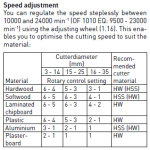Holmz said:
Is there an advantage to not using a drill?
Or why wouldn't one plunge with a smaller bit and run around in a circle using a template?
Please understand that the Festool hinge boring bits are designed specifically for that purpose, so they are not the same as drill bits. They are also designed to stand up to the minimum speed of the OF1010, which is many times faster than drills.
In metal fabrication back in the old days there were precise machines known as jig borers used to make ultra accurate round holes which used the approach of moving the work piece under a stationary end mill cutter smaller than the desired hole in such a way the end mill created an accurate hole. For making fairly small through holes you would precisely drill a slightly under-sized hole. The next step would be to change from a drill bit to a reamer ground to create a round hole of exactly the desired diameter. For any number of reasons using reamers never worked out in the real world of woodworking. Trust me, 60 some years ago people coming to woodworking after gaining experience doing precision metalworking actually failed at attempts to make better quality holes in wood by using reamers. We made spectacular tear-out.
With the introduction of NC machining, that sort of control was added to refined end milling machines. One of the first popular uses was for production hole boring. The table of the NC end milling machine was caused to move to create a perfect round hole using a smaller end mill cutter.
Years later CNC came along, replacing the punched tape and cards of NC with computer software. In many applications the table holding the work remained stationary and the milling machine spindle is moved on a gantry under computer control. That increased production speed and made accuracy easier to achieve.
I got my start in metal working just before the NC era. I am not aware anyone seriously considered using NC in woodworking.
After the cost of CNC milling machines was reduced, for woodworking CNC routers were created. At first the cost of CNC routers was very high compared to other woodworking machines and yet far lower than for traditional metalworking CNC machines. Many current CNC routers can be used with softer metals and plastics, frequently using different spindles running at lower RPM.
With modern CNC routers a common approach for creating accurate round holes is to move the router bit in a circle, as you suggested using software as a virtual template. Festool has never confided in me how they produce the MFT-style work tables with precise 20mm dia holes on 96mm centers.
My cabinet shop makes our own very large MFT-style work tables using one of our CNC Routers. We use the software approach of using an under-size bit moved in a circle so that software creates the all-important 20mm round hole on exactly 96mm centers.
Again in the real world of making cabinet doors customers can afford, the makers of cup hinges accept that the holes bored in solid wood or sheet material will not be perfectly round, but when made with correctly designed cutters those shallow holes are accurate enough for the purpose. Notice that the hinges have a 'bezzle' which hides the hole holding the cup hinges from the client's view. In making cabinets it is the positioning of the hinge hole that is more important than the exact size of the hole. The grain of the wood frustrates creating perfect holes with a single bit, so the hinge system was created to work well in the real world.

